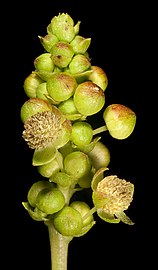Adriana quadripartita
| Adriana quadripartita | |
|---|---|

| |
| Scientific classification | |
| Kingdom: | Plantae |
| Clade: | Tracheophytes |
| Clade: | Angiosperms |
| Clade: | Eudicots |
| Clade: | Rosids |
| Order: | Malpighiales |
| Family: | Euphorbiaceae |
| Genus: | Adriana |
| Species: | A. quadripartita
|
| Binomial name | |
| Adriana quadripartita | |
| Synonyms | |
| |
Adriana quadripartita, the bitter bush, is a shrub in the family Euphorbiaceae. The species, which is endemic to southern Australia, has an erect open habit, growing to between 0.5 and 3 metres or more high.[2][3][4]
The lanceolate or ovate leaves are opposite, coarsely toothed and have a glabrous upper surface.[3][5] They are 5 to 10 cm long and 2 to 4 cm wide.[5] The male flower spikes are up to 17 cm long.[3] The female flowers, which occur on separate plants, appear in clusters.[5] These are followed by ovoid capsules which are about 1 centimetre in diameter.[2]
Forms[edit]
There are two recognised forms, one with wholly glabrous leaves and another pubescent form with leaves which are whitish tomentose on the underside.
Glabrous form[edit]
This form, also known as rare bitter-bush or Adriana quadripartita sensu stricto, occurs in Western Australia, South Australia and in Victoria where it reaches its eastern limit at Port Phillip heads.[2][4][5] This form is listed as "threatened" in Victoria under the Flora and Fauna Guarantee Act 1988.[6]
Pubescent form[edit]
This form, also known as coast bitter-bush, is sometimes recognised as a species in its own right – Adriana klotzchii. It occurs on sand dunes along the coast of South Australia and into Victoria as far east as Wilsons Promontory.[3][5] In South Australia, flowers are mostly produced in spring but may appear year round.[3] This form is a host plant of the bitter-bush blue butterfly (Theclinesthes albocincta).[7]
Cultivation[edit]
The species can be propagated by cuttings. The pubescent form may be used as a protective screen planting against salt-spray in coastal areas.[8]
Gallery[edit]
-
kvinna
-
Male
References[edit]
- ^ "Adriana quadripartita". Australian Plant Name Index (APNI), IBIS database. Centre for Plant Biodiversity Research, Australian Government, Canberra. Retrieved 2009-07-28.
- ^ a b c "Adriana quadripartita". Electronic Flora of South Australia Fact Sheet. State Herbarium of South Australia. Archived from the original on 2012-11-27. Retrieved 2009-07-28.
- ^ a b c d e "Adriana klotzchii". Electronic Flora of South Australia Fact Sheet. State Herbarium of South Australia. Retrieved 2009-07-28.
- ^ a b "Adriana quadripartita". FloraBase. Western Australian Government Department of Biodiversity, Conservation and Attractions.
- ^ a b c d e Costermans, L. (1981). Native Trees and Shrubs of South-eastern Australia. Australia: Rigby. ISBN 072701403X.
- ^ "Threatened List (November 2008) - Flora and Fauna Guarantee Act 1988" (PDF). Department of Sustainability and Environment. Retrieved 2009-07-28.
- ^ "Bitter-bush Blue" (PDF). Eco Voice. Archived from the original (PDF) on 2016-03-06. Retrieved 2009-07-28.
- ^ Wrigley J.W. and Fagg M. (1979). Australian Native Plants. William Collins Publishers Sydney, Australia. ISBN 0-00-216416-7.


